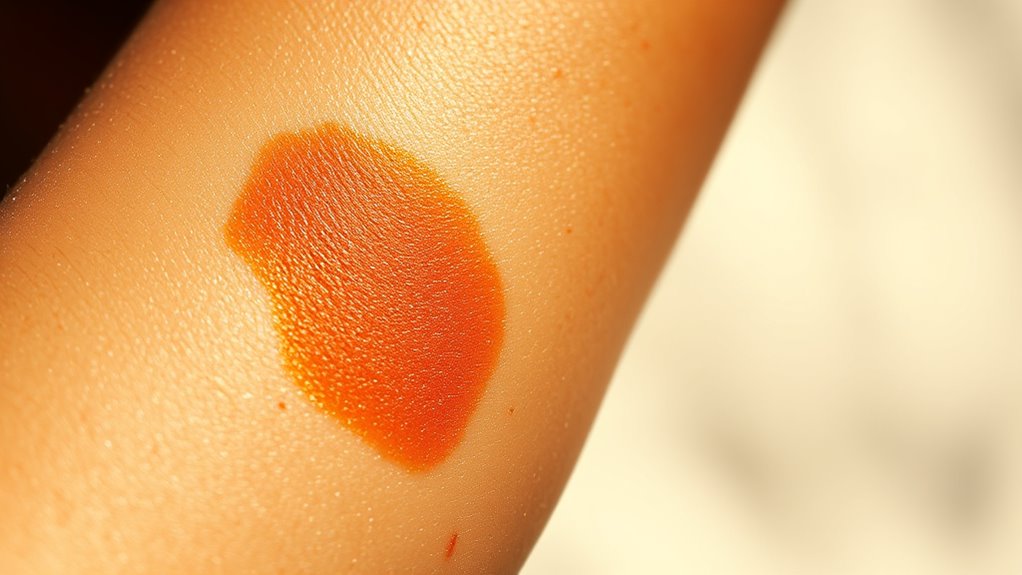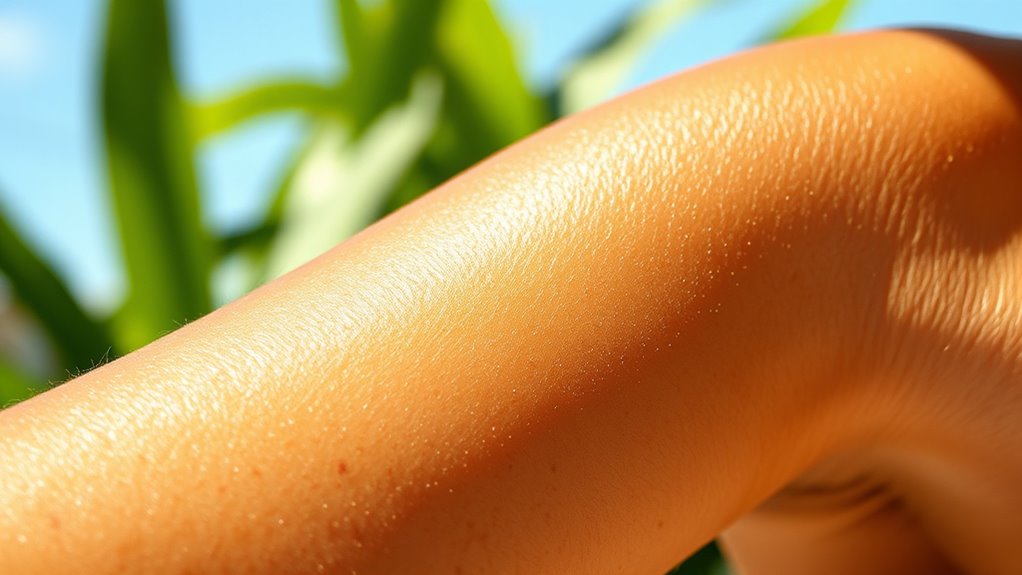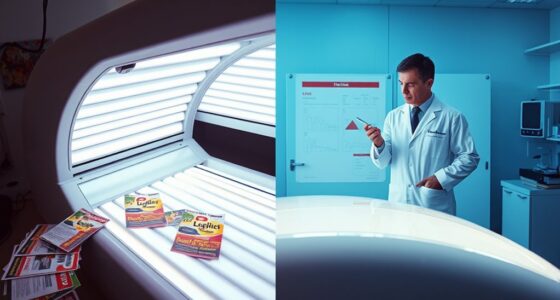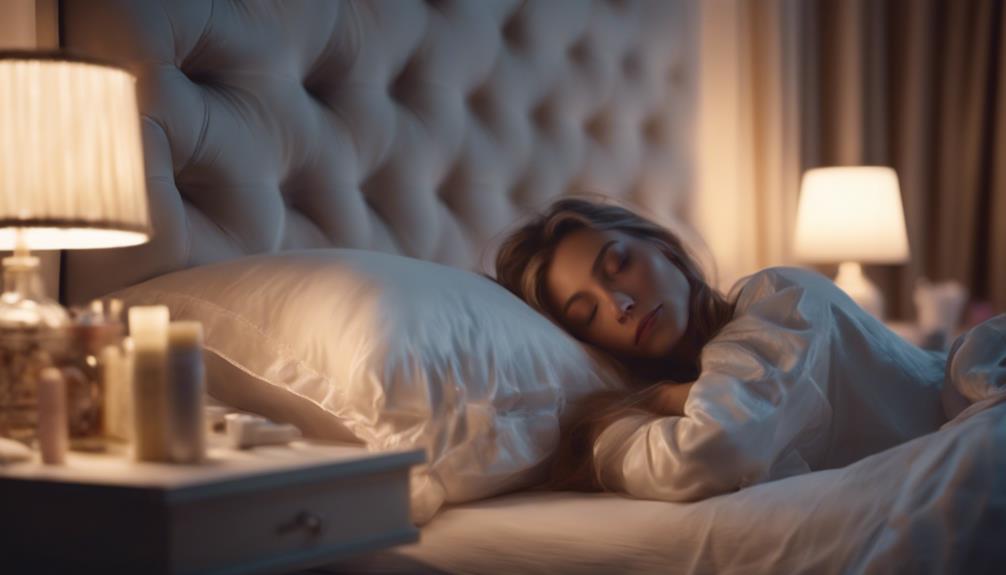A tan doesn’t protect your skin from UV damage; it actually shows skin has already been harmed by exposure. Many believe a base tan prevents sunburns, but it offers only minimal protection—much less than sunscreen with SPF 30+. Relying on a tan can lead to overexposure, increasing your risk of skin aging and cancer. To stay safe, it’s best to avoid unnecessary UV exposure altogether. Keep exploring to learn more about how to protect your skin effectively.
Key Takeaways
- A base tan provides minimal protection and is not a safe way to prevent sunburn.
- Tanning indicates skin damage; it does not offer true or lasting UV protection.
- Relying on a tan instead of sunscreen increases the risk of skin damage and skin cancer.
- Both natural sun exposure and tanning beds cause cumulative skin harm over time.
- The safest strategy is to avoid UV exposure and use broad-spectrum SPF 30+ sunscreen.

Many people believe that getting a “base tan” can protect them from sunburns and reduce skin damage, but this myth is dangerous and unfounded. A tan, whether from the sun or a tanning bed, is your skin’s response to UV exposure, which causes your skin to produce more melanin. While it might appear appealing, a tan isn’t a shield against further harm. Instead, it signals that your skin has already been damaged, and the more UV exposure you get, the higher your risk of long-term skin issues, including premature aging and skin cancer. Tanning beds, in particular, are a significant source of UV exposure. They emit concentrated UV rays that can be even more intense than natural sunlight, exposing your skin to high levels of radiation in a short period. This increased UV exposure dramatically raises your chances of developing skin problems later on.
Many assume that a base tan will prevent sunburns during outdoor activities, but this isn’t true. A tan offers only a minimal increase in your skin’s natural defense, which is nowhere near enough to block the harmful effects of UV rays. In fact, a tan provides less protection than wearing a broad-spectrum sunscreen with at least SPF 30. Relying on a tan to protect you is a dangerous misconception that can lead to overexposure. When you think you’re protected because of your tan, you might spend more time in the sun without taking proper precautions, further increasing your risk of sunburn and skin damage. Remember, UV exposure is cumulative. The more your skin is exposed to UV rays over time—whether from the sun or tanning beds—the greater your chances of developing serious health issues.
Tanning bed risks are particularly concerning because they often involve intense UV exposure in a short amount of time, which can be more harmful than natural sunlight. Many people don’t realize that tanning beds are classified as carcinogenic by health authorities, similar to tobacco. Regular use increases the likelihood of melanoma, basal cell carcinoma, and squamous cell carcinoma. The false sense of security that a base tan provides can lead you to use tanning beds more frequently or stay in the sun longer, unaware of the real danger. The bottom line is that a tan isn’t a sign of health or protection; it’s a sign of skin damage. Protecting yourself from UV exposure by wearing protective clothing, seeking shade, and applying broad-spectrum sunscreen is the safest approach. Don’t fall for the myth that a tan offers any real protection—it’s your skin’s way of saying it’s been harmed.
Frequently Asked Questions
Can a Base Tan Reduce the Risk of Sunburn?
A base tan might seem like it could help with sunburn prevention, but it actually doesn’t offer significant tanning benefits or protection. Relying on a base tan can give you a false sense of security, leading to more sun exposure and increased skin damage. Instead, protect your skin with broad-spectrum sunscreen, seek shade, and wear protective clothing. Remember, no tan completely shields you from harmful UV rays.
How Does a Base Tan Compare to Sunscreen Protection?
Think of a base tan as a flimsy shield against UV exposure—it’s like a painted-on armor that barely holds up. While it might slightly darken your skin and influence skin pigmentation, it doesn’t provide reliable protection like sunscreen. Sunscreen acts as a sturdy barrier, absorbing or reflecting UV rays, whereas a base tan offers minimal defense. Relying on it is like trusting a paper umbrella in a storm—ineffective and risky.
Is Indoor Tanning a Safe Alternative for a Base Tan?
Indoor tanning might seem like a safe way to get a base tan, but it’s actually risky. You expose your skin to intense UV rays, increasing your chances of skin damage and skin cancer. Tanning misconceptions can lead you to believe it’s safe, but indoor tanning risks outweigh any perceived benefits. Instead, protect your skin with sunscreen and avoid tanning beds altogether for safer, healthier sun habits.
What Are the Long-Term Skin Health Effects of a Base Tan?
A base tan doesn’t protect your skin from long-term damage. It causes increased skin pigmentation and stimulates melanin production temporarily, giving the appearance of some protection. However, this pigmentation is a sign of skin injury, which can lead to premature aging, wrinkles, and a higher risk of skin cancer over time. Instead of relying on a base tan, protect your skin by using broad-spectrum sunscreen and avoiding excessive sun exposure.
Does a Base Tan Prevent Skin Cancer?
You might think that a base tan prevents skin cancer, but that’s a common tanning misconception. Tanning myths like this suggest that some tans offer protection, but they don’t. A tan is your skin’s response to damage, not a shield. No tan can prevent skin cancer. Instead, it increases your risk. Protect your skin by avoiding indoor tanning and using broad-spectrum sunscreen, not by chasing a base tan.
Conclusion
So, don’t fall for the myth that a base tan offers real protection. Even if you think it’s harmless, UV exposure still damages your skin and raises skin cancer risk. Some say a little sun won’t hurt, but every tan is a sign of skin injury. Protect yourself with sunscreen and seek shade instead of relying on a fake sense of safety. Your skin will thank you for making smarter choices today.









